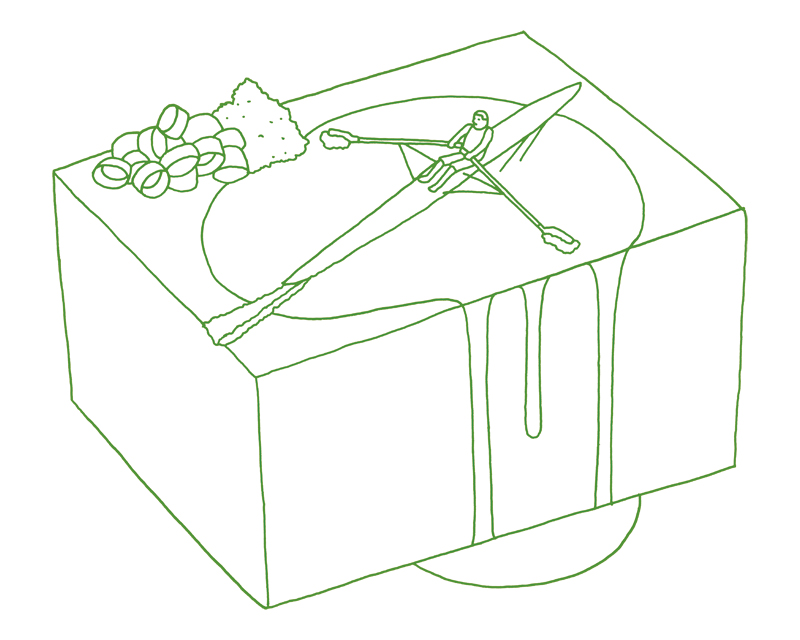Sports Research at the University of Tokyo
It is not just athletes who are seriously into sports at the University of Tokyo. In this section we introduce some of the "powerful Socrates" at the University, faculty members who are daily engaged in research and education relating to sports. Several sports researchers from among the many at the University of Tokyo describe the most interesting themes in sports research today.
“Affordance”
Discussing sport from the perspective of “environment”

Illustration: Jo Okada
Does water afford humans the ability to swim like a fish?
This is a story I heard firsthand from a rehabilitation expert. It related to a person who had had both legs amputated below the knee and whose rehabilitation involved swimming in a pool environment. Initially the double amputee would attempt to swim by kicking the portion of his legs that remained?his thighs. Although it is possible to stay afloat using this method, it is impossible to swim in a forward direction. However, after several days of practice in the pool, it appears that the movement of the entire body transforms, as if by magic. The thighs, lower back and upper torso apparently work together as one to create a “swishing” movement similar to the movement of a fish. This movement is not possible other than in a water-based environment, hence it can be said that this movement has been “afforded” by the water itself.
In the case of rehabilitation from a stroke actual items are used. If a person has suffered paralysis on one side of their body, they are subsequently unable to use both hands to handle items, as the paralyzed hand cannot do what the brain is telling it to do. For such patients in the rehabilitation process it can help to use soap. Lathering hands with soap helps to reduce friction and therefore helps both hands to rub together more effectively.
In both of the above cases it is human beings who are actually doing the movements. However, the items they use or the places they are in are involved in this movement. Recently in psychology, the quality of an object, or an environment, which empowers an individual to perform an action has come to be known as “affordance.” This word has been created from the verb “to afford,” or in other words “to give,” or “to provide.”
In the field of sport, new types of affordance are being discovered. I have actually written a book, based on interviews with 16 top-class athletes from Japan, who are all in the global top eight in their particular sports (note).
Let us take the example of Ms. Reiko Shiota, a badminton doubles player who retired from competition last year. According to Ms. Shiota, she sees the court as a series of discrete sections. These are two sections each at the front, sides and rear of the court (a total of six sections), in addition to which she also segments the height above the court into three sections: the height below her waist, the height from her waist to her shoulder, and the height above her shoulder. The court is therefore divided into a total of 18 sections. Directly after an opponent has hit the shuttlecock, she envisages which of these discrete areas it will pass into, even though it has an initial speed of 250km/h. Her degree of error is only a few centimeters. In this way we can see that Ms. Shiota perceives the area around her body as being part of her and she moves accordingly.
In an interview with Olympic bronze medalist in 500m speed-skating Mr. Manabu Horii, I discovered that when cornering in an anti-clockwise direction, rather than feeling the presence of the actual wall on his right-hand side, he was more aware of a perceived wall on his left-hand side. When skaters lean inward in response to the centrifugal force pressing outwards, they relax their physical power and a “wall” appears on their left-hand side. When this occurs, apparently all that then needs to be done is to press your shoulder against this imaginary wall and it becomes possible to ensure that your skating remains straight and true and your steps stay in alignment. By taking larger strides it is then apparently possible to take the corners at high speed.
A rower who considers the water surface to be life tofu?
Rower Mr. Daisaku Takeda (single sculls) is a world champion and has also competed in five consecutive Olympic games. According to Mr. Takeda the water surface when rowing is like “tofu.” The single sculls boat is only 30cm wide and even when a 70kg rower is aboard it sinks no more than 8cm. Mr. Takeda describes this inherently unstable boat as “standing” in the water, and states that he only gets the feeling that he is stably afloat on a few occasions each year. On the occasions when he has done well, it is due to the fact that the water, oar and body become one. He states that he rows with his oar in the same manner as you would place a knife in soft tofu without causing it to crumble. He likens the feeling of rowing to moving on tofu.
The above are all anecdotes, but they are taken from actual interviews with athletes. From these stories we can clearly understand that the secret to success in sport is to discover the way to become one with your environment.
Hearing these stories makes me want to go and see these sports myself and savor the atmosphere of the sporting arena. It is a treat for the senses and I hope that University of Tokyo students will also go and experience this atmosphere for themselves from time to time.
Note: “The ability to see a 250km/h shuttlecock: Body theories on top-class athletes” (Kobunsha Shinsho).





